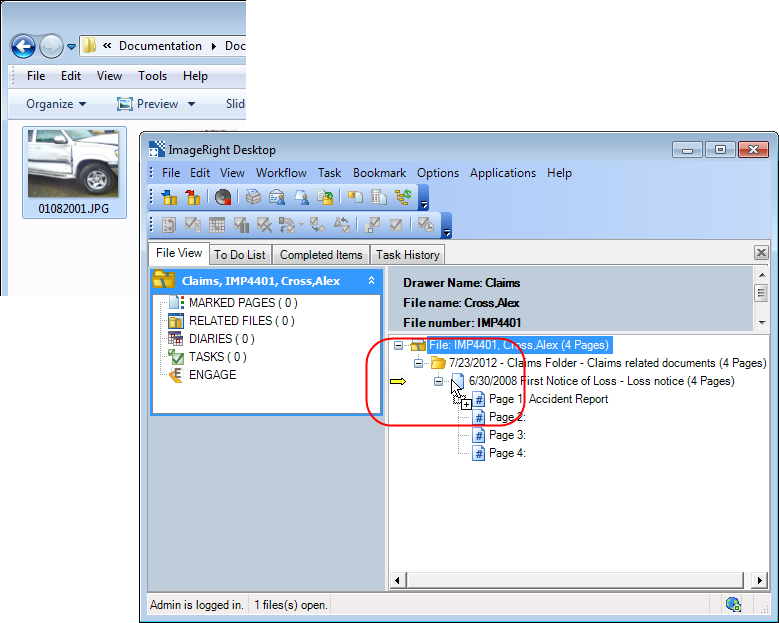Attach Files
Using the Attach Files command, you can add files from outside ImageRight to an ImageRight file. The command provides support for all file types, for example, photographs, word processing documents, spreadsheets, and it is not necessary to convert the files to an image. That is, the files will be attached in their native format.
Typically, most ImageRight users attach files to an open file; however, you can use the Attach command without opening a file first. In our example, we will open a file first. You can skip this step if necessary.
|
For more information about the options in the Import dialog box discussed later, see Import Dialog Box Explained. |
- Open the (target) file in ImageRight Desktop to which the item should be attached.
- On the Edit menu, point to Attach, and then click Files.
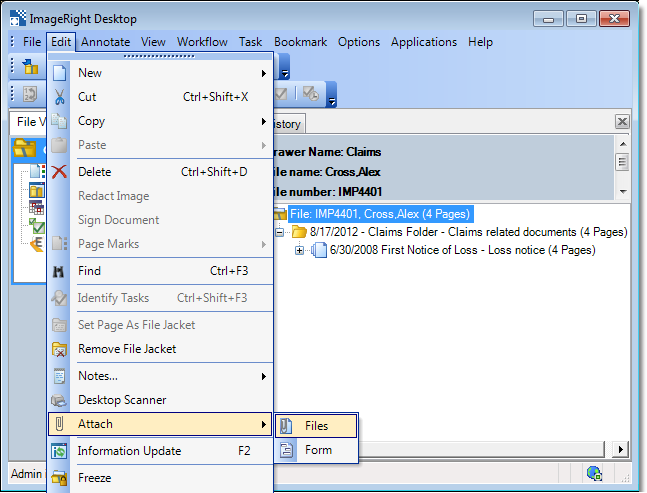
- In the Open dialog box, locate the item to be attached, a photo in our example, and select it.
- Click Open or simply double-click the file.
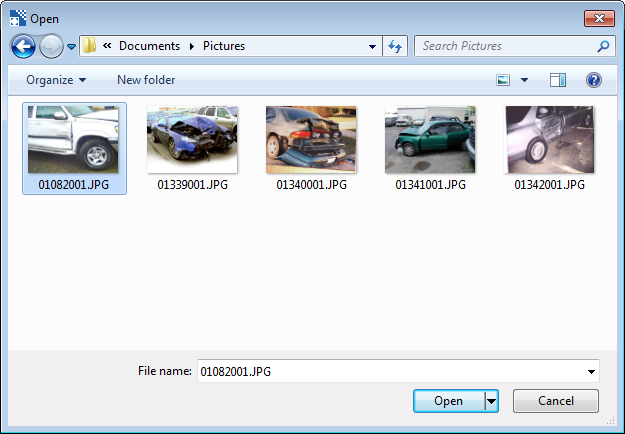
- When the Import dialog box opens, you are ready to configure the filing options to be applied.
- The items that are being import appear on the right side of the Preview tab. You can select an item in the list and see a preview on the left side.
- If multiple
items appear in the list on the right, you can change the order of the
pages in a document. Select the page that you would like to move and click
 (move up) or
(move up) or  (move
down) on the right side of the dialog box as needed.
(move
down) on the right side of the dialog box as needed. - To prevent
an item from being stored in the file, select the item in the list and
click
 . Items remaining in the list will
be filed based on the options you configure as explained later.
. Items remaining in the list will
be filed based on the options you configure as explained later. - You can
redact an image before it is imported. Click
 to use
the redaction tool. For more information about redacting an image, see Redact Image. It is important to note that
when you complete the import of an image that you redacted, a copy of
the original image is not created. Only the redacted image will be viewable
in Desktop.
to use
the redaction tool. For more information about redacting an image, see Redact Image. It is important to note that
when you complete the import of an image that you redacted, a copy of
the original image is not created. Only the redacted image will be viewable
in Desktop. - You can
change the size of the page being previewed by doing one of the following:
- Drag the mouse pointer over a section (draw a box around a section). When you release the mouse button, the section will be enlarged.
- Double-click the enlarged page to restore the size.
- Right-click the image, and then click a command on the menu to change the size (fit) of the preview.

- On the Import Into tab, you configure the options related to the file structure, that is, the options that direct where the item will be filed.
- In the
File info pane, select the destination where you would like to place the
item.
- Current file and position
- Current file
- New file
- New temporary file
- Existing file
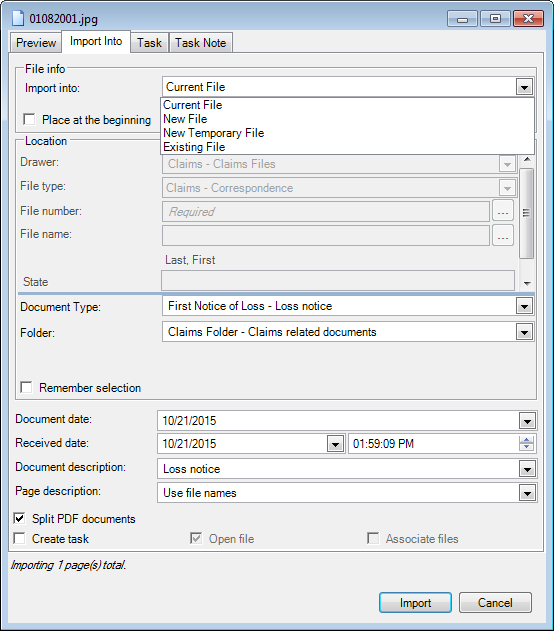
- With the Current File and Position or Current File option selected, select Place at the beginning, and the item will be placed at the beginning of the file (the first document in the first folder).

- In the
Location pane, select the file structure related information that you
would like applied.
- Drawer
- File type
- File number (File number is unavailable if New temporary file is selected.)
- File name (File name is unavailable if New temporary file is selected.)
- Document Type
- Folder
- Select
the Remember selection option, indicated by
 , and
the last used file structure items that you selected will be remembered
and presented the next time the Import dialog box opens.
, and
the last used file structure items that you selected will be remembered
and presented the next time the Import dialog box opens. - As needed,
you can change the following dates and time by entering the new values:
- Document date
- Received date and time (Typically, the received date is only changed for e-mail messages so that messages can be displayed in Desktop in the order they were received.)
|
If you have selected the option in Desktop Settings to split imported content into multiple documents, the document date and the received date cannot be changed when you are importing multiple documents. |
- As needed, you can enter a description in the Document description or Page description boxes. The entered descriptions will be displayed in Desktop, replacing the system generated descriptions. The display of the entered document description is optional and is turned on in File Tree Options.
- Select the Create task option to create a task related to the item being imported. Selecting this option updates the same option on the Task tab. The workflow, etc., selected on the Task tab, as explained later, will dictate where the task is created.
- Select the Split PDF documents option and multipage PDF documents will be added as a document with multiple pages displayed in the file tree. For more information about splitting PDFs, see Split PDFs into Individual Pages.
- If you
are creating a new file or a new temporary file, you can:
- Select the Open file option, and the file will be opened in Desktop after the import process completes.
- Create a related files relationship between the new temporary file and the file open in ImageRight Desktop. To do so, select the Associate files option.
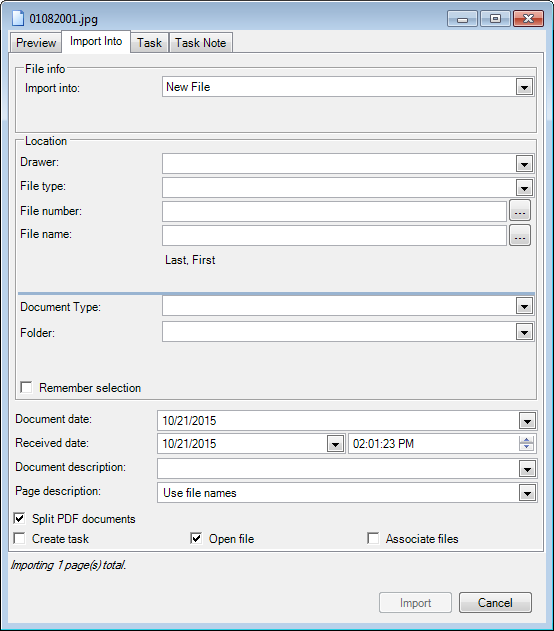
- On the
Task tab, select the Create task option if you would like to create a
task on the items being imported. Selecting this option updates the same
option on the Import Into tab. Enter (select from the lists) the following
information:
- On first page – To create the task on the first page of the document.
- On the document – To create the task on the document, not just a single page.
- Available
on – The date and
time the task will be available in the ImageRight To Do List. To change
the date and time values do one of the following:
- Select the date and time values and type new values as needed.
- Click the value to be changed and use the arrow keys to change the value. The left and right arrow keys are used to advance or return to a value to be changed. The up and down arrow keys are used to change the value.
- Click the arrow next to the date to open a calendar. Use the arrow keys at the top of the calendar to change the displayed month as needed. Click the desired day to select it.
- Click the arrows next to the time to change the time or select the time element to be changed and type the new value.
- Description – The text description that will be associated with the task and displayed in the navigation bar. Enter a description of the task in the box. As an alternative, you may click the down arrow and select a description that was used previously.
- Workflow – The workflow in which the task will be created.
- Step – The workflow step in which the task will be created.
- Assign to – The name of the person, group, or role to which the task will be assigned.
- Priority – The order of importance assigned to the task (0 – highest to 9 – lowest).
- Lock task – The file will be opened, and the task will be locked.
- Debug task – The task can be used for testing workflow changes. This option is typically used by the person who maintains your organization's workflows. Tasks will be added to the workflow and can be processed without affecting actual production workflow tasks, reporting, etc.

- You can
add a note (optional) to the task if needed.
- Click the Task Note tab.
- Type the text of the note in the Note text pane.
- Click Import (Import/Task) to complete the import process. Click Cancel to end the import process.
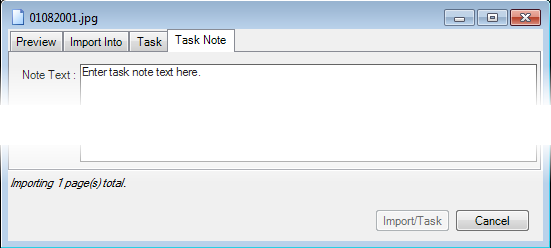
In the Import dialog box, you can select from two different view styles in the area where you select the folder and document. In our earlier example, we demonstrated the selection of the file structure information from drop-down lists on the Import Into tab. Now, we want to show you how to change the appearance so that you can select the information in a tree view.
- Right-click in the folder/document
area and click Switch View to change to a hierarchical tree view. Click
 or
or  as
needed to expand the folder types of the hierarchy, and then select the
document type.
as
needed to expand the folder types of the hierarchy, and then select the
document type.
|
Folder types in which
repeatable folders can be created are identified with |
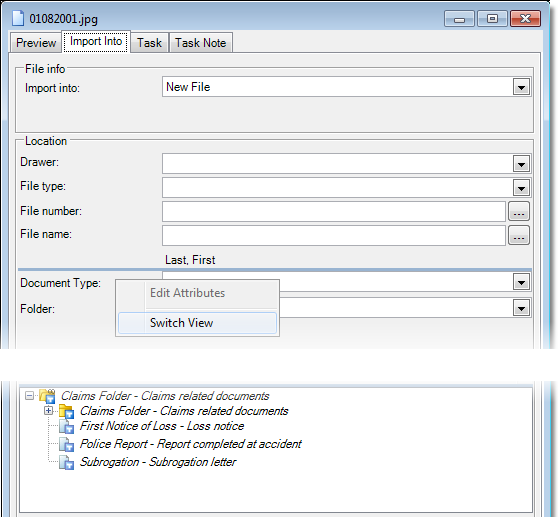
Your organization may associate attributes like state, policy type, agent name, etc., with ImageRight files. If so, you can edit the attributes while using the Attach command. For more information, see Import Dialog Box Explained.
The appearance of the Import dialog box will change as shown in our example if you attach files other than photographs, for example, a word processing document. In our example, the Word document can be opened in Microsoft Word by clicking the appropriate link.
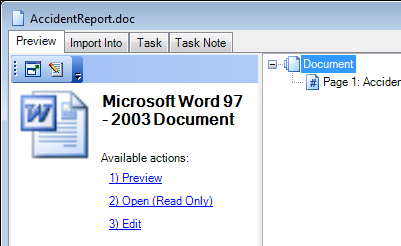
Attach with Drag-and-Drop
In addition to using the Attach Files command, you may also drag files from a source outside ImageRight, even graphic files, and drop them in an open file. You can also drag e-mail messages from Microsoft Outlook and add them to an ImageRight file.
We are going to demonstrate how to drag a file from a local directory and drop it in a file. You can modify our steps as needed to drag e-mail messages that are in Outlook.
- Open the (target) file in ImageRight Desktop to which the item should be attached.
- Locate the item to be attached as we did in the top portion of the screen capture.
- Drag the
item to the open file and drop it in the appropriate location as shown
in the bottom portion of the screen capture. An arrow appears to highlight
the area where the item will be placed. The appearance of the arrow changes
as you move your mouse to help you determine placement.
 –
The Import dialog box will be opened when you point at the file
or folder level. You select the filing options as explained earlier. If
you point at the document level, the item will be added as the first page
of the document. If you point at a page of the document, the item will
be placed after the page.
–
The Import dialog box will be opened when you point at the file
or folder level. You select the filing options as explained earlier. If
you point at the document level, the item will be added as the first page
of the document. If you point at a page of the document, the item will
be placed after the page. –
The item will be placed after the position at which the mouse is pointing.
–
The item will be placed after the position at which the mouse is pointing. –
The item will be placed before the position at which the mouse is pointing.
–
The item will be placed before the position at which the mouse is pointing.
